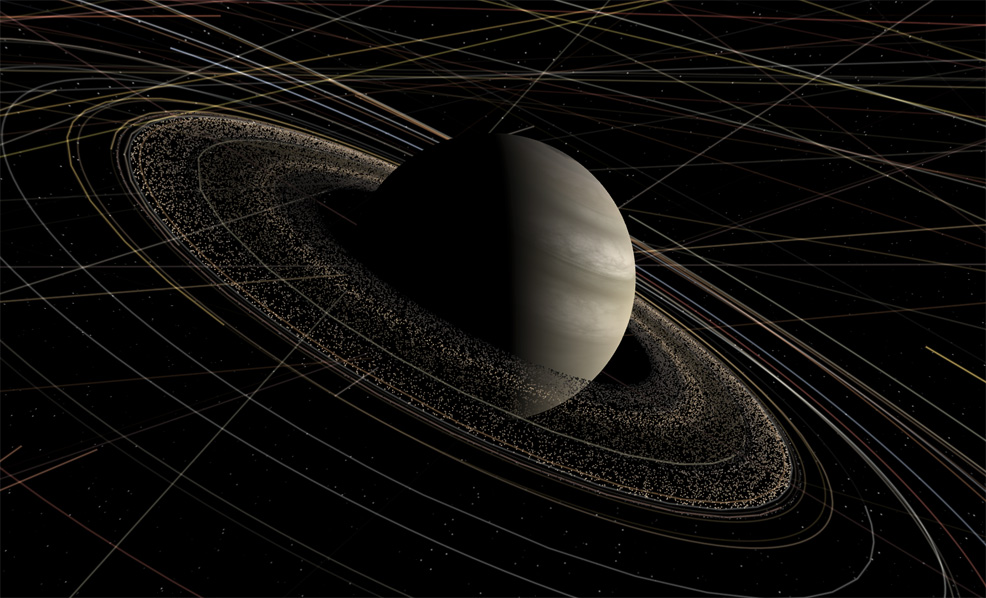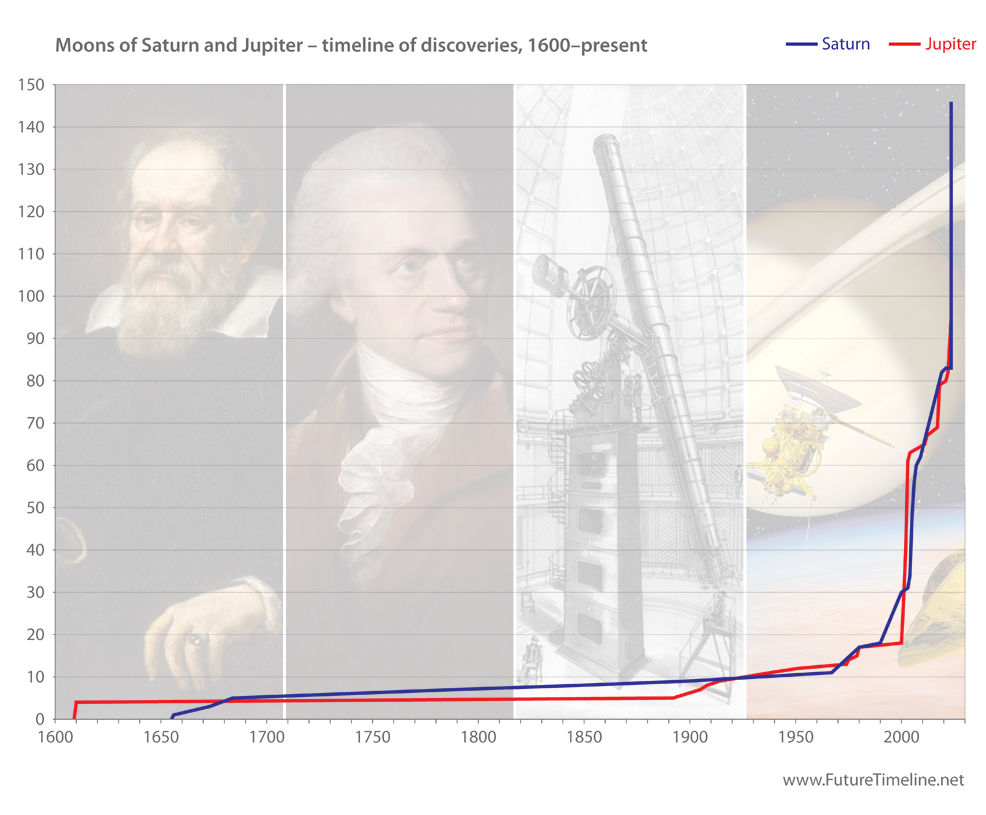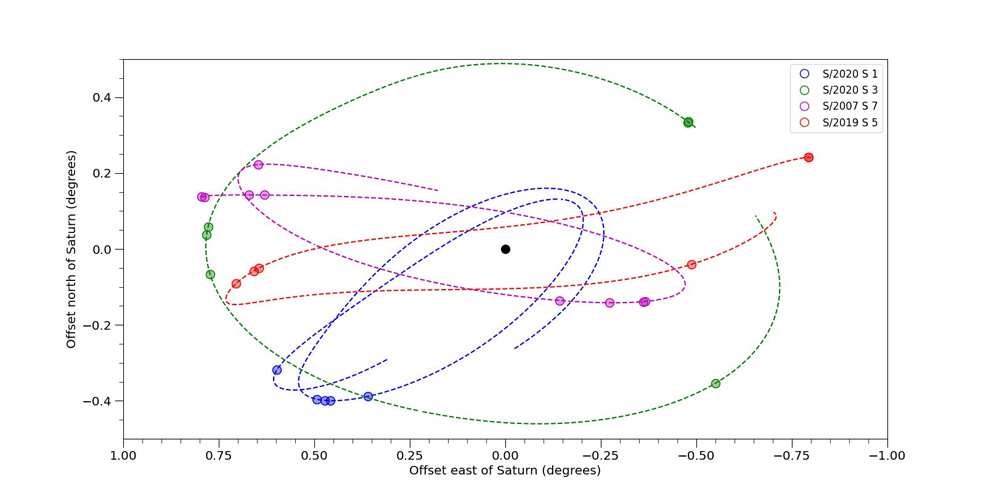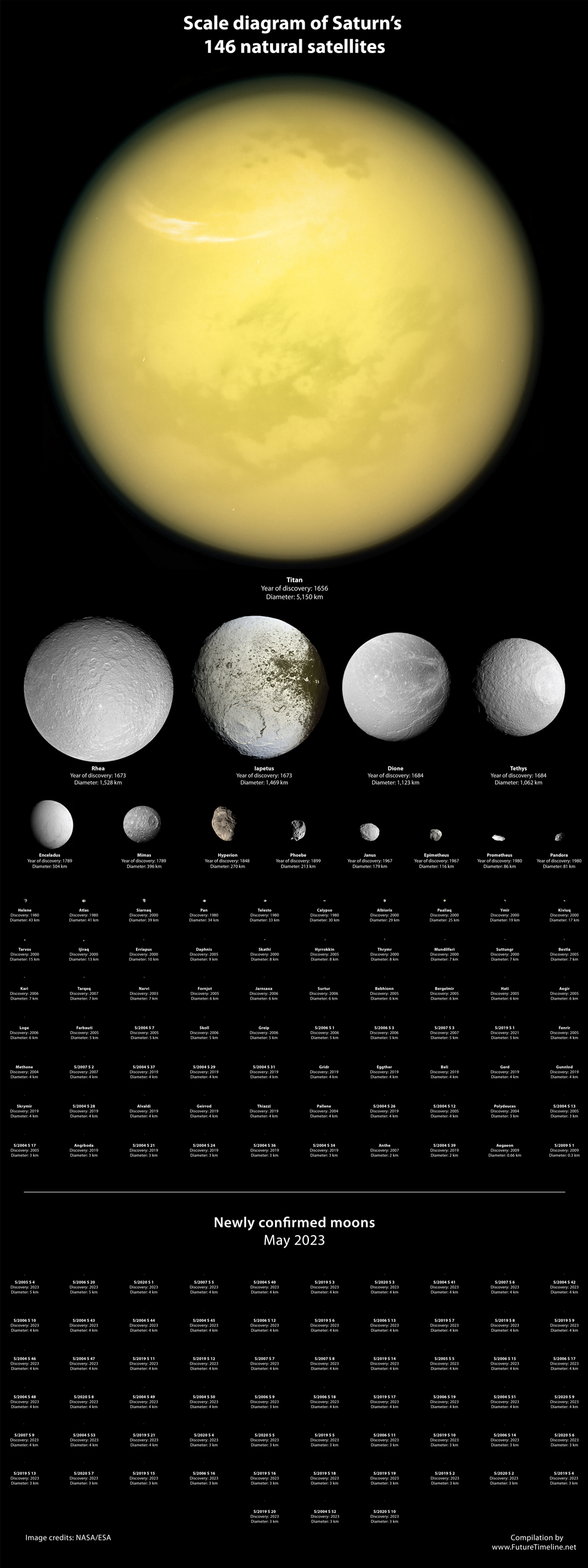
29th May 2023 63 new moons of Saturn discovered The discovery of 63 new moons of Saturn is reported by the Minor Planet Center in Cambridge, Massachusetts, bringing the gas giant's total confirmed number to 146 and overtaking Jupiter.
Saturn, the sixth planet from the Sun and the second largest in our Solar System, has long captivated astronomers and space enthusiasts. In addition to its striking and beautiful ring system, the gas giant has a vast array of natural satellites. The discovery of Saturn's moons began in 1655, when a Dutch scientist named Christiaan Huygens identified Titan, Saturn's largest moon, and accurately described the orbital characteristics. Its official confirmation, the following year, came four decades after Galileo's observation of the largest Jovian moons. Huygens' discovery became the fifth moon other than Earth's to be made known. More discoveries followed later in the 17th century with Rhea, Iapetus, Dione, and Tethys revealed by Italian astronomer Cassini. However, it would be another 105 years before British astronomer William Herschel confirmed the existence of Mimas and Enceladus – and a further 60 years before any more of Saturn's moons could be confirmed. The advent of space exploration and modern telescopes led to an acceleration of discoveries from the late 20th century onwards. Voyager 1 uncovered several previously hidden moons as it passed through the Saturnian system in 1980, while revealing the already known moons in stunning detail. The early 21st century has seen an explosion in the number of confirmed natural satellites around Saturn, alongside further improvements in image resolution and even the first photograph from the surface of Titan. In addition to a wealth of new scientific discoveries from the Cassini-Huygens mission, dozens of additional moons have since been spotted by astronomers including Scott Sheppard of the Carnegie Institution in Washington, whose findings we covered in 2019. The latest major haul – a total of 63 new moons – has now been verified and confirmed by the Minor Planet Center in Cambridge, Massachusetts. This new tally is by far the largest ever recorded, increasing Saturn's moon count by more than 75%, from 83 to 146. Since Jupiter has 95, this makes Saturn the first planet known to host over 100 moons. Viewed from a historical perspective, as shown in the graph below, this growth appears even more rapid. Somewhat like Moore's Law, we can see that modern observation techniques have led to an exponential acceleration of discoveries. The Jovian and Saturnian systems are both far larger and more complex than previously thought. Could even more moons be uncovered in the future? Robotic and human explorers may be studying their surface details and perhaps exploiting their resources for centuries to come.
Edward Ashton, a postdoctoral fellow at Taiwan's Institute of Astronomy and Astrophysics, led this research. His team used a technique known as 'shift and stack' to find fainter (and thus smaller) objects. This method has previously been used for Neptune and Uranus, but never for Saturn. Shifting a set of sequential images at the rate that a moon is moving across the sky results in enhancement of the moon's signal when all the data is combined, allowing those too faint to be seen in individual images to become visible in the 'stacked' image. Ashton and his colleagues used data from the Canada-France-Hawaii Telescope (CFHT) on top of Mauna Kea, Hawaii. They shifted and stacked images taken during three-hour spans and painstakingly matched objects detected on different nights over two years. "Tracking these moons makes me recall playing the kid's game Dot-to-Dot, because we have to connect the various appearances of these moons in our data with a viable orbit", explains Ashton, "but with about 100 different games on the same page and you don't know which dot belongs to which puzzle." All of the new moons are in the "irregular" class, characterised by their large, elliptical, and inclined orbits compared to regular moons. They are clumped into distinct orbital groups, named after different mythologies: the Inuit group, the Gallic group, and the much more populated Norse group. Some examples can be seen in the diagram below (Saturn is represented by the central black dot).
A better understanding of the orbital distribution could provide insight into the collisional history of Saturn's moon system. Based on their previous studies, Ashton's team has suggested that the large number of small moons on retrograde orbits is the result of a relatively recent (in astronomical terms, being in the last 100 million years) disruption of a moderately-sized irregular moon, now broken into the many fragments being catalogued in the Norse group. "This project is only made possible due to the superb data provided by the CFHT's attention to excellent image quality, the huge field of view of its MegaPrime digital camera, and the excellence of its telescope operations staff," said Ashton. There are now 83 confirmed moons of Saturn that are still unnamed. Most are likely to receive names from Gallic, Norse, and Inuit mythology, based on the aforementioned orbital groups they are a member of. The new moons are tiny. Even the largest is a mere 5 km (3.1 mi), less than half the diameter of Mars' outermost moon, Deimos. The smallest is estimated to be less than 3 km or 1.9 miles across. For comparison, Titan has a diameter of 5,150 km (3,200 mi) and is the second largest moon in the Solar System. To illustrate the sheer number of moons that are now known to orbit Saturn, we have put together a scale diagram showing them all together. Please click for a larger version.
Click to enlarge
Comments »
If you enjoyed this article, please consider sharing it:
|










